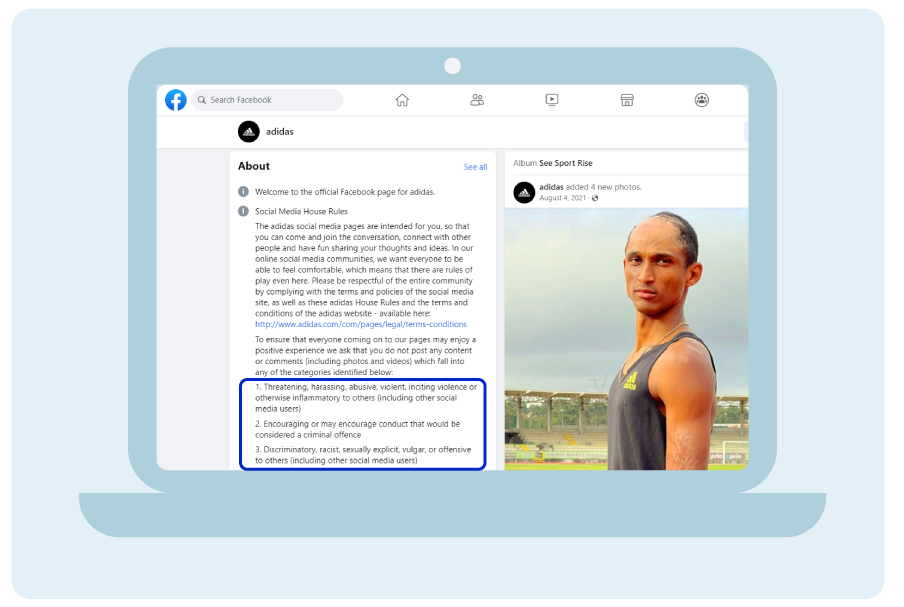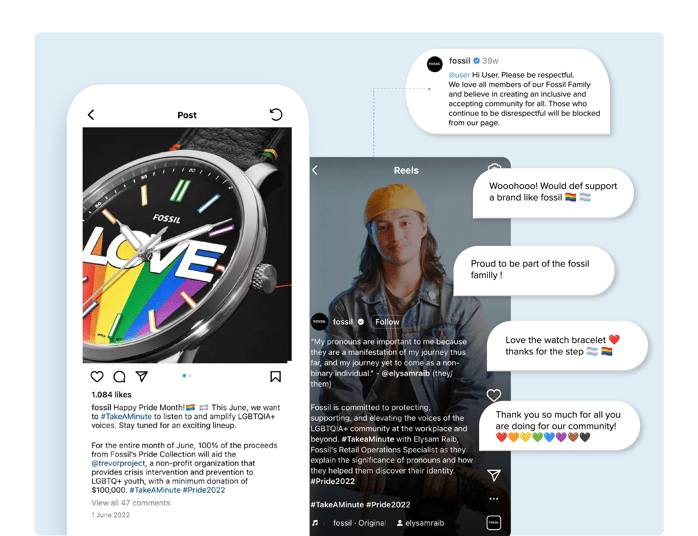
How to Deal with Hate on Pride Month Social Media Campaigns
Pride Month is a time when many brands show their support for the LGBTQ+ community through various campaigns. It is a time of celebration, love, and acceptance for the LGBTQ+ community.
Unfortunately, not everyone shares the same sentiment, and hate comments can become prevalent on social media platforms during this time. These comments can be hurtful, triggering, and damaging to one's mental health. In this blog post, we'll explore strategies to deal with hate comments during Pride Month.
Table of content
How brands should support LGBTQ+ during Pride Month and beyond
Many brands are turning to Pride Month as an opportunity to showcase their commitment to diversity and inclusivity. However, simply adding a rainbow to your logo is not enough - this is what people call rainbow washing. So if you’re just getting started, we recommend you to:
- ❤️ Show allyship but commit to year-round support
- 🧡 Use inclusive language
- 💛 Highlight LGBTQ+ voices
- 💚 Share educational resources
- 💙 Donate to LGBTQ+ organizations
- 💜 Use inclusive visuals and ensure diverse representation
- 🤍 Engage with your community
Are you looking for inspiration for your Pride social media campaigns and posts? Check our blog post "8 Pride Month Social Media Posts Ideas".
How to deal with hate comments on Pride Month social media campaigns
As the world celebrates Pride Month, many brands are taking the opportunity to show their support for the LGBTQ+ community. However, with increased visibility comes increased attention, and, sometimes, negative feedback. That's why it's important to be prepared to handle social media comments during the month of June. You should start by reviewing your social media guidelines and establishing rules on how you'll be dealing with haters.
Brands should not ignore or leave their comment sections unsupervised during Pride campaigns. This could make them appear complicit in the spread of homophobic and hateful comments. By proactively monitoring and taking action on such comments, brands can demonstrate their commitment to promoting inclusion and diversity. This will send a clear message that such negative comments on social media will not be tolerated.
Brands can employ three main strategies to deal with these types of comments on social media during Pride Month campaigns:
1) Hide all hateful comments
The first strategy is to hide all comments that are homophobic or hateful across your Pride Month social media posts. This strategy creates a safe online environment for the LGBTQ+ community and prevents the spread of hate speech.
One example of a brand that employs the strategy of hiding all homophobic and hateful comments is Adidas. Adidas has a clear social media policy that prohibits any form of hate speech or discrimination.

Adidas sends a clear message that discrimination and hate speech has no place in their brand by hiding all hateful comments
2) Leave visible, but reply to hateful comments
The second strategy is to leave some of the hateful comments visible but reply to them in an informative way. This approach promotes dialogue and educates people about the LGBTQ+ community.
One example of a brand that uses this strategy is Fossil. During their Pride Month campaign, Fossil decided to respond to negative comments in an informative way. They also mentioned that disrespectful users will be blocked from their page.

3) Reply to hateful comments and hide them after
Another strategy that brands can employ is to reply to hateful comments and hide them afterward.
By responding, the brand emphasizes their commitment to promoting diversity and inclusivity. At the same time, they also educate their audience on the importance of creating a safe and accepting environment for everyone.
Secondly, by hiding the comment after replying, the brand avoids providing a platform to hate and homophobia.
This strategy can help brands strike a balance between responding to critics and hiding hateful comments. Some may choose to leave mild critics and their replies visible while hiding those that are overtly hateful or discriminatory. This way, they can address legitimate concerns while avoiding spreading harmful content.
So, which strategy is better for your brand?
When deciding which strategy is better for your brand, there are several factors to consider.
1. Your brand values and DEI strategy.
Do you prioritize standing out and educating customers about inclusivity, or do you prioritize fighting against giving hate a platform? If your brand values align with the former, hiding all hateful comments may be the better strategy when replying to comments. Alternatively, if you aim to promote dialogue and education, replying to comments may be a more suitable approach.
2. Your resources
Auto-hiding everything that is offensive requires way fewer resources than replying to each comment. If you have limited resources, you can use a tool like BrandBastion Lite to auto-hide all offensive comments using AI. If you're looking for a highly precise and comprehensive solution for comment moderation, then BrandBastion Safety is the ideal solution. It features AI technology and a team of expert human content specialists who work 24/7 to moderate comments. This will ensure your brand maintains a positive online presence while avoiding a resource drain.
3. Your industry
Brands in more conservative industries, like finance or insurance, may find the first strategy (hiding all hateful comments) more effective. For brands in progressive industries, like fashion or beauty, the other strategies may be more adequate.
4. Your audience
Would your audience react positively if you respond to hate comments? Do they support your brand's stance against hate comments? To gauge this, you can use social media monitoring tools with keywords like "LGBTQ+", "Pride Month", "hate speech", and "discrimination". This can help you understand what your audience is saying about your approach toward LGBTQ+ issues.
In summary...
Whichever strategy your brand chooses, it's important to be committed to promoting inclusivity and equality. It's crucial for brands to acknowledge that leaving their comment section unmanaged is not an option, particularly during Pride Month campaigns. When brands ignore or fail to address hateful comments, they may appear complacent and insensitive to the LGBTQ+ community's needs. Therefore, it's crucial to actively manage social media comments and respond appropriately.
|
Personal opinion from the author: In my personal opinion, creating a positive environment for the LGBTQ+ community is essential for brands. To achieve this, brands need to establish clear boundaries and enforce them, particularly when it comes to social media comments. While mild criticism can be addressed through educational responses, escalated hateful and homophobic comments must be hidden. Moderation will shield your community and thwart the spread of hostility. These comments have the potential to cause significant harm to the mental well-being of those who encounter them. It is also the brand's responsibility to protect and shield their community from such negativity. |